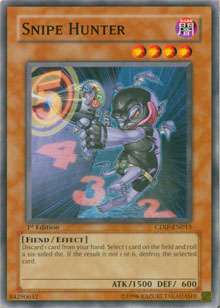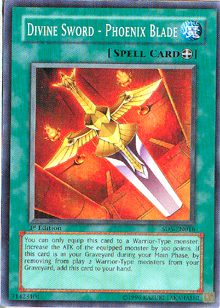 After Snipe Hunter saw its first Top 8 appearance at a Shonen Jump Championship, it became rare not to see it in local tournament decks and lists posted up on the various online communities. Oftentimes, it would be in a deck that it didn’t belong in, since the particular build couldn’t deal with the loss of cards that Snipe Hunter can create. Perhaps the riskiest part of this card is that you only have a two-thirds chance of destroying something, meaning that you may end up spending two or three cards in order to destroy one. Sometimes, you’ll just be unlucky and waste your entire hand, only to fail on each roll!
After Snipe Hunter saw its first Top 8 appearance at a Shonen Jump Championship, it became rare not to see it in local tournament decks and lists posted up on the various online communities. Oftentimes, it would be in a deck that it didn’t belong in, since the particular build couldn’t deal with the loss of cards that Snipe Hunter can create. Perhaps the riskiest part of this card is that you only have a two-thirds chance of destroying something, meaning that you may end up spending two or three cards in order to destroy one. Sometimes, you’ll just be unlucky and waste your entire hand, only to fail on each roll!
And yet despite how I originally felt about Snipe Hunter, I’ve slowly begun to see its uses in current decks. The die-rolling Fiend has slowly moved from decks it doesn’t belong in to decks that take full advantage of the fact that Snipe Hunter’s effect is not limited to once per turn. Other players just take advantage of the fact that it’s one of the best discard outlets in the game.
Snipe Hunter isn’t very big. At 1500 ATK, it is vulnerable to both Deck Devastation Virus and Crush Card Virus, if you are unfortunate enough to go up against the latter at a Shonen Jump Championship. His 1500 ATK wouldn’t have cut it a few months ago when Breaker the Magical Warrior was still legal for tournament play and Hydrogeddon was still a dominant sight. Yet, despite these monsters’ place in the Advanced format, Snipe Hunter saw play in certain Gadget decks where it probably didn’t belong. The other deck it appeared in, though, was the first that really took advantage of it in every way: Bazoo Return.
One of the key factors to Bazoo Return was its ability to fill up its own graveyard with monsters to remove with an effect like Bazoo the Soul-Eater’s. Snipe Hunter was just one of the ways in which spare Machines could be pitched to the graveyard, while also giving the Bazoo player a chance to blow up the opponent’s set spells or traps. Once the opposing back row was clear, Bazoo the Soul-Eater could feast on whatever monsters were discarded by Snipe Hunter, and then a Dimension Fusion or Return from the Different Dimension could bring those monsters back for a lethal battle phase. The deck was explosive, but it needed a consistent way to put Machine monsters into the graveyard other than Future Fusion. Card Trooper and Snipe Hunter both fulfilled this role. Card Trooper could also grant its user an extra card when it was destroyed, and Snipe Hunter could actually clear an entire board of opposing spells and traps before the deck went off. This was what made Snipe Hunter popular in the first place.
In fact, Snipe Hunter was one of the best cards ever released for a deck such as Bazoo Return. A very proactive deck that relied on an explosive single turn could easily make use of its strengths. If a player needed to win the game that turn, Hunter would make sure it happened. The Bazoo Return player’s hand size isn’t relevant if he or she can win off a huge Return from the Different Dimension that turn, and Snipe Hunter not only fueled the effects of Return from the Different Dimension, but it also made sure that the turn went exactly as the Bazoo Return player wanted.
Since then, Snipe Hunter has seen a huge surge in play, though it has been limited to the decks that the Fiend belongs in: proactive decks that just need to make sure the opposing spell and trap zone is clear in order to go off. Sometimes Snipe Hunter is used on monsters, but that’s rare because these decks have plenty of ways to deal with them. The only problem might be a face-down monster, which has become a rare sight in many matchups since the start of the new Advanced format. Rogue decks and classic Monarch Control strategies are usually the only decks a player will see setting a monster, though the occasional Spirit Reaper may be played face down in defense position.
Snipe Hunter’s importance in the Advanced format has evolved since Bazoo Return, becoming one of the more important alternative options to Destiny Hero–based decks, including Destiny Monarchs and Destiny Hero beatdown. Like the other tournament-winning Destiny Hero deck to come out of this format—Diamond Dude Turbo—the Destiny Hero–based beatdowns can be extremely explosive. As such, Snipe Hunter is a perfect fit in these decks to make sure that the opponent’s spell and trap zone is clear. But unlike a deck such as Bazoo Return, which really needs to ensure a secure field in order to have an effective kill turn, Destiny Hero–based beatdown strategies also have access to Metamorphosis in order to use Ryu Senshi, who is also stellar at suppressing the threat of an opposing trap card. In this regard, Snipe Hunter serves as a useful tool by being another option that can clear the opponent’s spell and trap zone in order to push for an unexpected win.
This does not take away from Snipe Hunter’s most recognizable purpose for the Destiny Hero beatdown deck, which originated with Bazoo Return. Snipe Hunter is still one of the best discard outlets in the game, giving its users the ability to discard cards to the graveyard easily and as many times as they want. The benefit from Snipe Hunter is that you have a potentially destructive effect to go along with the little Fiend, which makes it the preferred discard outlet of choice for decks such as Bazoo Return. The Destiny Hero beatdown strategy specifically loves the use of Snipe Hunter, which serves as an alternate way to discard Destiny Hero - Malicious when the player does not have access to Destiny Draw. In this case, Snipe Hunter serves as a way of making up for the beatdown deck’s lack of Lightning Vortex and Magical Shard Excavation, which were discard tricks to which Diamond Dude Turbo had access.
 In fact, with Magical Shard Excavation Limited to one per deck now, Snipe Hunter can serve as a solid discard outlet for DDT by being able to put cards from the combo player’s hand into the graveyard with ease. This isn’t limited to Destiny Hero - Malicious, either. Sometimes, DDT players need to remove Warriors in their graveyard from play, and discarding Divine Sword - Phoenix Blade can help in this purpose. It also allows the DDT duelist to discard tribute monsters that can be special summoned through graveyard recursion, such as Dark Magician of Chaos. All of this is done while also giving DDT players a potentially useful effect, if the die roll favors them.
In fact, with Magical Shard Excavation Limited to one per deck now, Snipe Hunter can serve as a solid discard outlet for DDT by being able to put cards from the combo player’s hand into the graveyard with ease. This isn’t limited to Destiny Hero - Malicious, either. Sometimes, DDT players need to remove Warriors in their graveyard from play, and discarding Divine Sword - Phoenix Blade can help in this purpose. It also allows the DDT duelist to discard tribute monsters that can be special summoned through graveyard recursion, such as Dark Magician of Chaos. All of this is done while also giving DDT players a potentially useful effect, if the die roll favors them.
Snipe Hunter has grown on me in the past few months. Its usefulness as a destructive tool really is only a bonus to the purpose it typically serves as an unmitigated discard outlet for decks that need to put cards into the graveyard. The Destiny Hero–based decks, specifically, can really take advantage of this effect right now, making Snipe Hunter one of the better level 4 monsters in the game at the moment. Whether or not you use the card, you’ll have to be ready to deal with its effect, because many decks can justify running two or even three copies of Snipe Hunter.